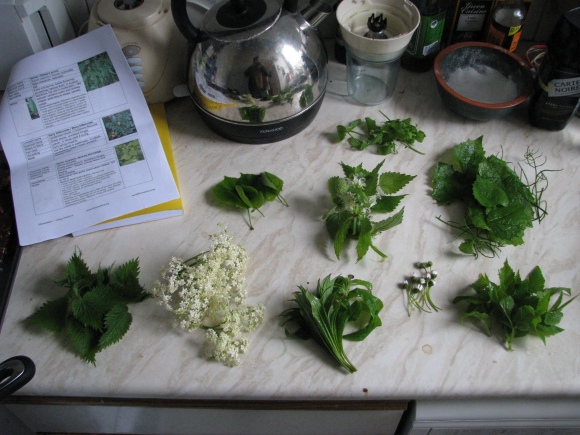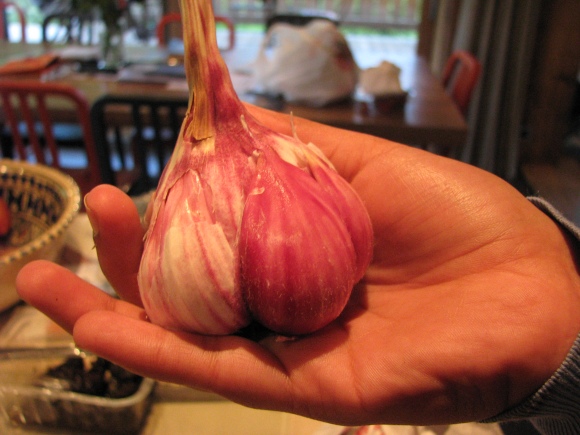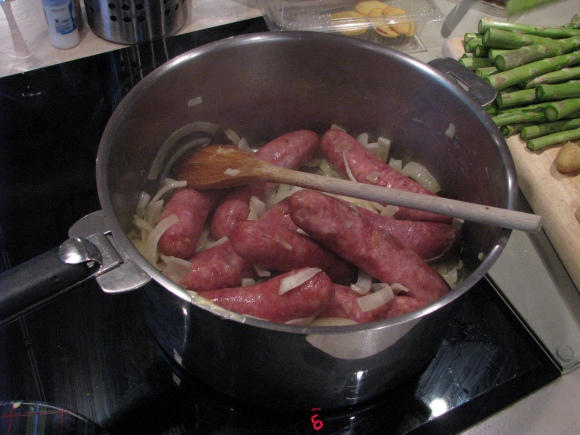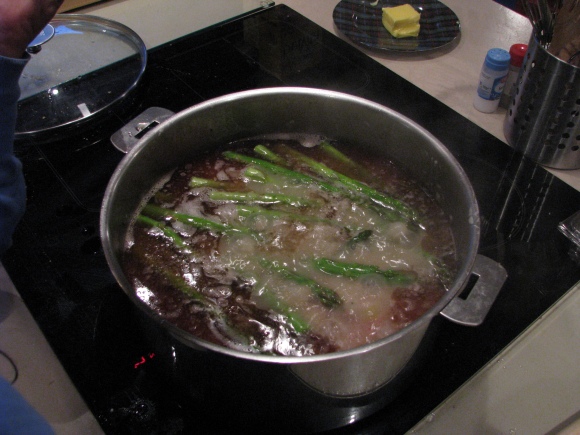So the other weekend we took a walk on the wild side! We went on a foraging and cookery workshop with Floramedica medical herbalist Anna Canning and the chefs of Spoon at Arthur’s Seat in Edinburgh. Anna told us that all of the plants belong to the queen, but she doesn’t mind if we only swipe a few leaves, so lay off, beefeaters!
Anna was excellent- incredibly knowledgeable about plant edibility and nutrition, medical properties and folklore. She also knew all the pitfalls of foraging and made sure no one accidentally poisoned themselves. Among our foraged foods were nettles, rosebay willow herb, sticky willy, wild garlic mustard or jack-by-the-hedge which was our favourite because it tastes like garlic!, chickweed, daisies, and elderflower. Anna also let us sample a selection of her herbal teas. She was our herbal sherpa.

From left: Nettles, elderflower, rosebay willow herb, daisies, ground elder; (next row up from left) lime tree leaves, birch leaves, garlic mustard; (at the top) chickweed
Afterwards we went to Spoon with all the plants we had gathered and the chefs at Spoon cooked us something like seven different dishes, right in the kitchen! We had- two different dips with rosebay willow herb and wild garlic mustard with veggie dippers, nettle soup, haddock patties with (I think) sticky willy, some squirrel stew with assorted herbs, pearl barley risotto, a wild herb and daisy salad, with elderflower pannacotta to finish, as well as three or four herbal teas. Head chef Rory even broke out some home-made elderflower wine for us to taste! It was such a great experience seeing the chefs work right in front of us, and the staff at Spoon have an intuitive knowledge of what taste combinations were going to work- they had to improvise a bit (it’s the nature of cooking with foraged food), and everything tasted delicious! The most important lesson was that it is really easy to integrate foraged food into dishes you are already comfortable with, and often the best recipes are the simplest ones!
We were so inspired after we left that, as soon as we had finished digesting our huge lunch, we had to start cooking again! We made two pestos- a stinging nettle pesto, and a garlic mustard pesto (with a bit of chickweed and rosebay willow herb). We decided to pesto-ise as we had picked a whole bunch of stuff and wanted to make something before we went on holiday. We also picked a bunch of elderflower and made elderflower cordial which we will show you how to make. But first:
Some tips on foraging:
Wear hardy waterproof shoes and bring a raincoat if you live in this country as it will always rain.
Dont pick plants that are near roads or that dogs might have weed on.
Bring a hessian or cotton bag for gathering herbs. Some seperate plastic bags are good for seperating plants and also for storing herbs that you don’t want to mix (like nettles that will sting you) For plants like nettles bring some gloves or a plastic bag to help you pick them- a pair of scissors is also handy.
Do not uproot plants- usually the top few leaves of spring growths are best- but this can vary.
Go with someone who knows what they are doing, but if you go on your own make ure you bring a couple of books for cross referencing. usually one with pictures and one with photos is best as the same plant can often look different.
For the stinging nettle pesto:
Nettles are pretty awesome. Their stings are good for you-they get the blood flowing! Roman soldiers actually bought them to the British Isles, and used to hit their aching muscles with them after long marches in the cold to make sure they were still alive and increase circulation. They are also the loveliest green colour- so lovely that in the second world war the british government requested 100 tonnes of nettles to be collected to use their dye for camouflage. So if your greens need greening- just pick some nettles!
Nettles can be found during most of the year- Feb to Nov but the first spring growth is always best. The top few leaves are usually the best, but don’t pick them if they have started flowering (wiggly stringy green bits). Shady ones are also usually less bitter.
What you need:
A large bunch of nettles -4 or 5 cups worth
Grated parmesan cheese- a tbsp or two
A clove of garlic minced
200g Pine nuts- (or other nuts like walnuts)
a drizzle of lemon juice
About 1/4 cup of olive oil
salt and peps
So first carefully pick the leaves and put them into a pot of boiling water for a few minutes so they don’t sting your mouth. Drain- but keep the water to make yourself a hot cup of nettle tea while you continue pesto-ing. Run drained leaves under cold water so they keep their colour. Spin the leaves in a salad spinner or colander, then wrap in a paper towel to squeeze the excess moisture out. Lightly toast the pine nuts in a pan till golden. Toss everything into a blender with a tbsp of the olive oil and blend. Check the consistency and taste- drizzle in more oil/ lemon/parmesan if needed to taste.
For the wild garlic mustard pesto:
For the wild garlic mustard pesto the recipe was quite similar although we used some rosebay willow herb, chickweed, and sticky willy to add some complexity to the flavour. If you only have a few leaves just make a little pesto! You don’t need loads. It’s so easy and delicious! You can vary the consistency for a drier chunkier pesto, or a smooth oily one. It keeps in the fridge pretty well, and lasts longer if you remember to top it up with a dash of olive oil. Tastes great on toast or in your sandwich, as a soup topper, salad dressing, on pasta, in pasta dough, or on a lovely chunk of meat/fish.
For the elderflower cordial:
8 heads of elderflower
An orange
3 Tbsp Lemon juice
100ml water
500g sugar
A large bowl, strainer, tea towel, and bottle
Boil the water and add the sugar. Stir to dissolve- and when ready take off the heat and allow it to cool slightly. Zest orange peel into the mixture, and chop orange into slices. Place elderflower heads in a bowl ( make sure there are no insects on them).Pour over orangey sugar water, lemon juice, and the orange slices. Make sure as many of the flowerheads are covered with water as possible. Cover with a tea towel and leave for 48 hours- stirring occasionally. Strain mixture and place in a bottle. I used a lovely old whisky bottle that I thought I would never use (it pays to keep things you don’t need!) You can discard the strained out stuff although the orange slices taste yummy.
Enjoy this cordial diluted with water, soda, gin, or anything your heart desires! Nice with a slice of lemon or a sprig of mint or tiny weeny eledrflowers floating in your drink.You can also heat a little bit up and use it to drizzle over desserts.
Notes: you can eat the flowers but don’t eat the green bits. They’re bad for your kidneys. An easy way to get lots of flowers off the heads if you need them is using your fingers or a fork to comb through.






















